Solar power in Israel
The use of solar energy began in Israel in the 1950s with the development by Levi Yissar of a solar water heater to address the energy shortages that plagued the new country.[1] By 1967 around 5% of water of households was solar heated and 50,000 solar heaters had been sold.[1] With the 1970s oil crisis, Harry Zvi Tabor developed the prototype of the solar water heater now used in over 90% of Israeli homes.[2] There are over 1.3 million solar water heaters installed as a result of mandatory solar water heating regulations.

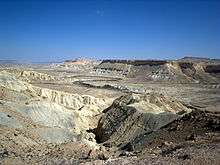
Israeli engineers have been at the cutting edge of solar energy technology[3] and its solar companies work on projects around the world.[4] However, even though Israeli engineers have been involved in both photovoltaic and concentrated solar power, the earliest Israeli companies which have become market leaders in their respective fields have all been involved in concentrated solar power. Some notable examples of this are BrightSource, Solel and Brenmiller Energy which all deal with utility scale projects. Additionally, Herzliya based SolarEdge has become a market leader in inverters for non-utility scale photovoltaic solar power.
In 2009, Israel found natural gas reserves within their exclusive economic zone which may reduce urgency of solar development. Solar technology in Israel has advanced to the point where it is almost cost-competitive with fossil fuels.[2] The high annual incidence of sunshine in the Negev Desert has spurred an internationally renowned solar research and development industry.[5] At the end of 2008, a feed-in tariff scheme was approved which has led to many residential and commercial solar energy power station projects.
Israel's objective is to produce 10% of the country's energy from renewable sources by 2020.[6]
History and development

In 1949, prime minister David Ben-Gurion offered Harry Zvi Tabor a job on the 'physics and engineering desk' of the Research Council of Israel, which he accepted. He created an Israeli national laboratory and created standards amongst the different measurements in use in the country, primarily British, Ottoman and metric.[7][8] Once the laboratory was established, he focused on solar energy for research and development.
Solar energy was particularly attractive because of the abundance and strength in Israel of the sun's rays and Israel's geographic latitude location is on the 30th parallel north, where the annual incident solar irradiance is 2000 kWh per m2.[5] Second, Israel lacks oil, and the conflicts with its neighbors made the procurement of a stable source of energy a national priority. In particular, it is argued that the best defense against missile attack felling the national power grid would be to build a distributed power network, which would mean solar fields of 25–50 megawatts across Israel.[9]
Early in the 1950s, Tabor began to examine why solar installations were inefficient. He eventually devised ‘selective black surfaces’, which his team at the National Physical Laboratory modified using nickel and chrome methods to blacken metals. These surfaces, which became known as Tabor surfaces, are particularly effective at trapping heat for use in solar water heaters.[10]
Tabor and French immigrant Lucien Bronicki developed a small solar power unit, the Organic Rankine cycle turbine, for developing countries with problematic power grids.[8][11] It was designed to neutralize the maintenance issues of reciprocating engines so it had only one moving part, the rotor. A 3 kWe prototype was exhibited at the 1961 United Nations Conference on New Sources of Energy in Rome, but it failed to find commercial success.[11]
| 2004 | 2005 | 2006 | 2007 | 2008 | 2009 | 2010 | 2011 | 2012 | 2013 | 2014 | 2015 | 2016 | 2017 | 2018 | 2019(forecast) |
|---|---|---|---|---|---|---|---|---|---|---|---|---|---|---|---|
| 0.9 | 1.0 | 1.3 | 1.8 | 3.0 | 24.5 | 69.9 | 190 | 237 | 481 | 731 | 780[13] | 905.6[14] | 1005[15] | 1450[16] | 2670[17] |
Dead Sea Solar pond
In 1965, Lucien Bronicki established Ormat Industries to commercialize the Organic Rankine cycle turbine concept. In the 1970s and 1980s Ormat built and operated one of the world's first power stations to produce electricity from solar energy; the plant was located at Ein Bokek near the southern part of the Dead Sea in Israel.[18]
The plant utilised a technology known as the solar pond, a large-scale solar thermal energy collector with integral heat storage for supplying thermal energy. It was the largest operating solar pond ever built for electricity generation and operated up until 1988. It had an area of 210,000 m² and gave an electrical output of 5 MW.[19]
Solar water heaters
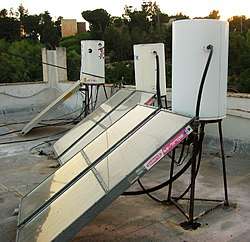
During the period of austerity in Israel in the 1950s, there was a fuel shortage, and the government forbade heating water between 10 a.m. and 6 p.m. As the situation worsened, engineer Levi Yissar proposed that instead of the construction of more electrical generation plants, homes should switch to solar water heaters. He built a prototype in his home, and in 1953 he started NerYah Company, Israel's first commercial manufacturer of solar water heaters.[1] By 1967 around one in twenty households heated its water with the sun and 50,000 solar heaters had been sold.[1] However, cheap oil from Iran and from oil fields captured in the Six-Day War made Israeli electricity cheaper and the demand for solar heaters dropped.[20] After the energy crisis in the 1970s, in 1980 the Israeli Knesset passed a law requiring the installation of solar water heaters in all new homes (except high towers with insufficient roof area). As a result, Israel is now the world leader in the use of solar energy per capita (3% of the primary national energy consumption).[21]
As of the early 1990s, all new residential buildings were required by the government to install solar water-heating systems, and Israel's National Infrastructure Ministry estimates that solar panels for water-heating satisfy 4% of the country's total energy demand.[2] Israel and Cyprus are the per-capita leaders in the use of solar hot water systems with over 90% of homes using them.[22] The Ministry of National Infrastructures estimates solar water heating saves Israel 2 million barrels (320,000 m3) of oil a year.[11]
Feed-in tariff
On June 2, 2008 the Israeli Public Utility Authority approved a feed-in tariff for solar plants. The tariff is limited to a total installation of 50 MW during 7 years, whichever is reached first, with a maximum of 15 kWp installation for residential and a maximum of 50kWp for commercial.[23] The National Infrastructures Ministry announced on December 2009 on expanding the feed-in tariff scheme to include medium-sized solar-power stations ranging from 50 kilowatts to 5 megawatts, though only one project was approved by June 2010.
Educational and research facilities
The Grand Technion Energy Program (GTEP)
Multidisciplinary scientists at Technion - Israel Institute of Technology are pooling resources at GTEP to advance the science behind solar power.
Nano science and solar energy
With its strong basis in nanotechnology and science, GTEP is pioneering the field of nano-energy.
- Efrat Lifshitz discovered that nano-sized materials consisting of nanocrystal quantum dots can absorb sunlight not only in the visible range, as materials currently used in solar panels do, but also in the infrared and UV ranges. This makes them ideal in photovoltaic cells used to turn sunlight into electricity, promising much more efficient solar power.
- Nir Tessler leads a group on organic photovoltaic material.
- Gitti Frey specializes in organic electronics - plastic electronics that are functional electronically and optically. They emit light and can transmit electrical signals, or absorb light and generate energy such as electricity. Frey introduces whole new properties in this field, creating effective and useful self-organizing structures on the nano-scale. Frey is working on a solar cell to convert sunlight into electrical energy. She predicts this research will lead to solar-power systems which are cheaper, unbreakable, flexible, more aesthetic and versatile.
National Solar Energy Center
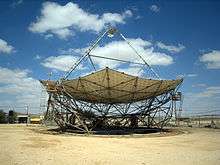
The National Solar Energy Center was founded in 1987 by the Ministry of National Infrastructures, and is part of Ben-Gurion University of the Negev.[24][25] In 2007, David Faiman, the Center's director, announced that the Center had entered into a project with Zenith Solar to create a home solar energy system that uses a 10-square meter reflector dish.[26] In testing, the concentrated solar technology proved to be up to five times more efficient than standard flat photovoltaic silicon panels, which would make it almost as cheap as oil and natural gas. A prototype ready for commercialization achieved a concentration of solar energy that was more than 1,000 times greater than that from standard flat panels.[2] According to Faiman, who led the Israeli team that developed the technology, 10% of Israel’s population (1,000 megawatts) could live on the energy from 12 square kilometres of land.[27]
Jacob Blaustein Institutes for Desert Research
The Jacob Blaustein Institutes for Desert Research facility was founded by Amos Richmond, and its faculty is part of the Ben-Gurion University of the Negev. It has a solar energy research program that has assisted in the development of passive heating, involving the mitigation of extremes of heat and cold in the desert through efficient storage from day to nighttime. One research project is an inhabited adobe house with rational fenestration. Prisms that transmit heat during the day are installed in the room and can be rotated to allow the heat to discharge at night.
There is a double-skin greenhouse that uses copper sulfate solution as a heat screen during the day. The liquid is pumped between the two skins, protects the interior from ultraviolet rays, and collects heat. At night the liquid is recirculated, returning the heat to the greenhouse.
Weizmann Institute Solar Research Facilities Unit
In addition to a solar reactor,[28] the solar research facilities of the Weizmann Institute of Science are among the most advanced laboratories in the world for concentrated solar energy research.[29] They have tested solar technology in the production of hydrogen fuel, which has been successfully trialled on a large scale.[30] Tareq Abu-Hamed, an Israeli scientist at the University of Minnesota, with colleagues Jacob Karni and Michael Epstein, head of the Solar Facility at Weizmann, were the developers of a new method to produce hydrogen fuel more cheaply, efficiently and safely while solving storage and transportation issues.[31]
Other innovations include harnessing sunlight for space communications and meteorological information; controlling light-dependent chemical reactions; and developing photodynamic cancer therapy.[32]
Solar power stations
The Negev
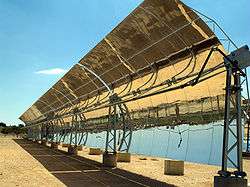
The Negev Desert and the surrounding area, including the Arava Valley, are the sunniest parts of Israel and little of this land is arable, which is why it has become the center of the Israeli solar industry.[33] David Faiman thinks the energy needs of Israel's future could be met by building solar energy plants in the Negev. As director of Ben-Gurion National Solar Energy Center, he operates one of the largest solar dishes in the world.[34]
In May 2016, the 50 MW Zmorot Solar Park came online. The plant uses 207,000-panel solar park and took 18 months to construct.[35]
In the Rotem Industrial Complex outside of Dimona, Israel, more than 1,600 solar mirrors focus the sun's rays on a tower to heat a water boiler to create steam. BrightSource Industries (Israel), Ltd., uses the solar array to test new technology for the three new solar plants to be built in California for Pacific Gas and Electric Company and Southern California Edison.[36][37][38]
Farming and kibbutzim

Israel's first solar power station opened in August 2008.[39] Moshe Tenne built the 50 KW plant on his Negev farm for NIS 1.3 million, and he expects to earn NIS 220,000 a year from selling excess electricity to the national power grid.[39] After the National Infrastructures Ministry announced it would expand its feed-in tariff scheme to include medium-sized solar-power stations ranging from 50 kilowatts to 5 megawatts, Sunday Solar Energy announced that it would invest $133 million in photovoltaic solar arrays for installation on kibbutzim.[40] In December 2008, the Sunday company announced that Kibbutz Reim in the western Negev would be the first community in the world to rely entirely on solar energy.[41] The Reim installation, costing NIS 60-100 million, would generate at least 2.5 megawatts during peak consumption. Excess energy would be sold to the Israel Electric Company. The investment is expected to pay for itself in 10 years, and the costs and revenues will be divided evenly between the kibbutz and Sunday.[41]
Arava Power Company
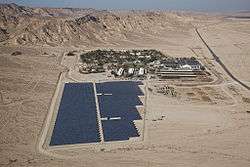
Ketura Sun is Israel’s first commercial solar field. Built in early 2011 by the Arava Power Company on Kibbutz Ketura, Ketura Sun covers twenty acres and is expected to produce green energy amounting to 4.95 megawatts. The field consists of 18,500 photovoltaic panels made by Suntech, which will produce about 9 gigawatt-hours of electricity per year.[42] In the next twenty years, the field will spare the production of some 125,000 metric tons of carbon dioxide.[43] The field was inaugurated on June 15, 2011.[44]
On May 22, 2012 Arava Power Company announced that it had reached financial close on an additional 58.5 MW for 8 projects to be built in the Arava and the Negev valued at 780 million NIS or approximately $204 million.[45] APC President and Co-Founder Yosef Abramowitz stated, "Our work is not yet done. Israel needs to adopt the European Union goal of 20 percent renewables by 2020 and this major milestone by Arava Power is proof positive that it can be reached. Furthermore, an injustice must be corrected by creating a special quota of solar fields for Bedouin land owners, who are locked out of the current solar program."[46]
Additionally, the Arava Power Company has signed multiple agreements with Bedouin families in the Negev desert to build solar fields on approximately 92 acres of land, with a production capability of up to 20 megawatts. APC has been lobbying the Israeli government to create separate solar caps for Bedouins.[47]
On February 7, 2012, Arava Power announced that it had received a license for the Tarabin Solar Field, the first solar field for the Bedouin community. Financing for the $30 million Tarabin installation is to be provided by OPIC – the Overseas Private Investment Corporation of the United States Government. Arava Power President Yosef Abramowitz sees solar power for the Bedouin as a positive example for Native Americans, First Nations, Aboriginals and others with historic land claims.[48]
Carmey Avdat Winery
Sunday Solar Energy was commissioned to build a solar installation for the Carmey Avdat winery in the Negev Desert. The 50 kW peak installation covers the 200-square meter roof of the winery and provides 65 percent of its annual energy needs.[49]
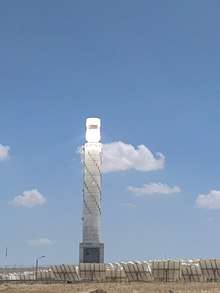
Kibbutz Samar
The Aora's Solar "Flower" Tower is the world's first solar hybrid power plant, comprising 30 heliostat solar reflectors. The plant switches to natural gas-powered turbines after dark so that it can continue producing power 24 hours a day.[50]
Ramat Hovav solar field
The Ramat Hovav solar field is 37.5 MW project near Ramat Hovav, operational since December 2014. The photovoltaic power plant is owned by Energix Renewable Energies Ltd It was built by the Belectric over a rehabilitated evaporation pond. The facility uses CdTe photovoltaic modules based on thin-film technology, manufactured by U.S. company First Solar, making it the country's largest PV power plant so far and one of the largest of its kind in the Middle East.[51]
Finance and business
Technology providers
- Kedma Solar is dedicated to bringing affordable renewable energy to Israelis through the use of solar mircrogrids.[52]
- SolarEdge is a provider of power optimizer, solar inverter and monitoring solutions for photovoltaic arrays. These products aim to increase energy output through module-level Maximum Power Point Tracking (MPPT).[53] Established in 2006, the company has offices in the United States,[54] Germany,[55] Italy, Japan, and Israel.
- Solaris Synergy developed a solution, which has been proven in operating water surface installations in Israel and is ready for commercial deployment worldwide.
- Solel has nine fields of solar collectors in the Mojave Desert of California.[56] It recently signed a contract to build the Mojave Solar Park, which will be the world's largest solar generating plant.[4][57]
- Soltell an advanced solution for operation and management of distributed solar photovoltaic facilities via the use of AI technology.
- Zenith Solar pioneered "concentrated solar power", claiming it to be up to five times more efficient than standard PV technology, making it almost as cost as traditional fossil fuels.[2] In December 2013, Zenith Solar was acquired by Suncore Photovoltaics Technology Company Limited, a Chinese-US joint venture that specializes in CPV.[58]
Holdings and Finance
- Arava Power Company was founded in 2006 on Ketura in the Arava Valley. On June 5, 2011, APC inaugurated Israel’s first medium sized solar field, Ketura Sun at 5 MW.
- Israel Cleantech Ventures is a venture capital fund that invests in the Israeli clean technology sector.
See also
References
- Petrotyranny by John C. Bacher, David Suzuki, published by Dundurn Press Ltd., 2000; Page 70
- At the Zenith of Solar Energy, Neal Sandler, BusinessWeek, March 26, 2008.
- Israel Pushes Solar Energy Technology, Linda Gradstein, National Public Radio, October 22, 2007.
- Looking to the sun, Tom Parry, Canadian Broadcasting Corporation, August 15, 2007.
- Solar Energy in Israel, David Faiman for the Jewish Virtual Library.
- Born-again Ziontist revolutionizing solar energy field, Haaretz
- Bright ideas, Ehud Zion Waldoks, Jerusalem Post, October 1, 2008.
- Harry Zvi Tabor, Cleveland Cutler, Encyclopedia of the Earth, 2007.
- The solar vote, Yosef I. Abramowitz and David Lehreer, Haaretz, November 2, 2008.
- Infrared Technology Fundamentals, by Monroe Schlessinger, Irving J. Spiro; CRC Press, 1995, ISBN 0-8247-9259-9; reference is at page 68
- Israeli Section of the International Solar Energy Society Archived 2009-01-11 at the Wayback Machine, edited by Gershon Grossman, Faculty of Mechanical Energy, Technion, Haifa; Final draft.
- International Energy Agency Photovoltaic Power System Programme
- http://www.iea-pvps.org/index.php?id=6&eID=dam_frontend_push&docID=3108
- http://www.iea-pvps.org/index.php?id=6&eID=dam_frontend_push&docID=3951
- http://iea-pvps.org/index.php?id=6&eID=dam_frontend_push&docID=4412
- https://www.haaretz.com/israel-news/business/.premium-israel-poised-for-energy-revolution-as-solar-prices-fall-1.7187095
- https://www.haaretz.com/israel-news/business/.premium-israel-poised-for-energy-revolution-as-solar-prices-fall-1.7187095
- Israel's 150-KW Solar Pond, Mother Earth News May/June 1980
- Carl Nielson, Aliakbar Akbarzedeh, John Andrews, Humberto R Becerra L and Peter Golding, 'The History of Solar Pond Science & Technology', Proceedings of the International Solar Energy Society, 2005.
- The Samuel Neaman Institute for Advanced Studies in Science and Technology — Publications — Solar energy for the production of heat Summary and recommendations of the 4th assembly of the energy forum at SNI Archived 2007-11-06 at the Wayback Machine
- Del Chiaro, Bernadette; Telleen-Lawton, Timothy. "Solar Water Heating (How California Can Reduce Its Dependence on Natural Gas)" (PDF). Environment California Research and Policy Center. Archived from the original (PDF) on 2007-09-27. Retrieved 2007-09-29.
- Approved — Feed-in tariff in Israel Archived 2009-06-03 at the Wayback Machine.
- Ben Gurion National Solar Energy Center Archived 2011-08-13 at the Wayback Machine
- Reflective mirrors seen raising solar potential, Ari Rabinovitch, Reuters, August 10, 2007.
- Zenith Solar’s Light of a Thousand Suns, Green Prophet, December 17, 2007.
- The Climate of Israel by Y. Goldreich, , Published by Springer, 2003, ISBN 0-306-47445-X
- Jacob Karni and Michael Epstein, Weizmann Institute, July 2002.
- Solar Energy Project at the Weizmann Institute Promises to Advance the Use of Hydrogen Fuel Archived 2016-03-03 at the Wayback Machine, American Committee for the Weizmann Institute, August 6, 2005.
- "Hydrogen | Properties & Uses". Priyamstudycentre. 2020-03-15. Retrieved 2020-08-15.
- The Crystal Connection: Solar Lasers in Space
- Head of Kibbutz Movement: We will not be discriminated against by the government Archived 2011-07-13 at the Wayback Machine, Ehud Zion Waldoks, Jerusalem Post, March 10, 2008.
- Giant solar plants in Negev could power Israel's future, John Lettice, The Register, January 25, 2008
- French PM Valls inaugurates Israel's latest—and largest—solar field, Jeruslaem Post, 05.23.2016
- Calif. solar power test begins — in Israeli desert, Associated Press, June 12, 2008; accessed December 23, 2008.
- Israel site for California solar power test, Ari Rabinovitch, Reuters, June 11, 2008.
- "Archived copy". Archived from the original on 2009-08-26. Retrieved 2011-10-09.CS1 maint: archived copy as title (link)
- Israel's first solar power station up and running in Negev, Avi Bar-Eli, Haaretz, September 18, 2008.
- Sunday Solar powers Israeli kibbutzim Archived 2008-12-24 at the Wayback Machine, Cleantech.com news, October 17, 2008.
- The first solar kibbutz, Amir Ben-David, Ynet, December 22, 2008.
- "Ketura Sun Technical Figures". Archived from the original on 9 March 2012. Retrieved 26 June 2011.
- "Ketura Sun Environmental Figures". Archived from the original on 22 July 2012. Retrieved 26 June 2011.
- "Arava Power Company". Archived from the original on July 7, 2011. Retrieved June 27, 2011.
- Roca, Marc (May 22, 2012), "Arava Closes Funding For $204 Million Israeli Solar Plants", Bloomberg, retrieved June 3, 2012
- Rabinovitch, Ari (May 22, 2012), "Israel's Arava power to build eight solar fields", Reuters, retrieved June 3, 2012
- Rinat, Zafrir (January 4, 2011), "Solar panels prove a money-spinner for Bedouin in the Negev", Haaretz, retrieved June 27, 2011
- Udasin, Sharon (February 8, 2012), "Regulator approves first Beduin solar license", The Jerusalem Post, retrieved February 29, 2012
- Day is Like Sunday Solar Energy, October 19, 2009
- First Hybrid Solar/Natural Gas Power Station Goes Online in Israel Popular Science Australia
- "Ramat Hovav solar field began to supply power to the grid (in Hebrew)". 24 December 2014. Retrieved 28 December 2014.
- "Kedma Solar | Israel | Solar Power at No Cost". Kedma Solar | Israel | Solar Power at No Cost. Retrieved 2016-08-24.
- "Frost & Sullivan Picks SolarEdge for Hot Investment Opportunity Award in European Solar Photovoltaic Market". Frost & Sullivan. 2009-09-10. Retrieved 2009-10-10.
- SolarEdge names former SMA America president John Berdner as North America GM
- "Germany to house SolarEdge's new solar sales office". Archived from the original on 2011-04-29. Retrieved 2018-01-09.
- dead link
- Israeli Solar Startup Shines
- China's Suncore represented by Barnea & Co. acquired the assets of Israel's Zenith Solar Archived December 24, 2013, at the Wayback Machine, Barnea & Co
External links
| Wikimedia Commons has media related to Solar energy in Israel. |
